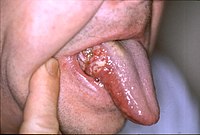
Photo from wikipedia
BACKGROUND Dentists play an important role in the detection and diagnosis of oral diseases, including oral cancer and its precursor lesions. There are few comprehensive reviews in the recent literature… Click to show full abstract
BACKGROUND Dentists play an important role in the detection and diagnosis of oral diseases, including oral cancer and its precursor lesions. There are few comprehensive reviews in the recent literature that examine the scope and trends of oral disease diagnoses by dentists. METHODS The authors analyzed all accessions to the Toronto Oral Pathology Service at the Faculty of Dentistry at the University of Toronto in Toronto, Ontario, Canada, from 2005 through 2015 using a custom-built database. They used these data to calculate the temporal trends in the diagnoses of oral epithelial dysplasia (OED) and oral squamous cell carcinoma (OSCC). RESULTS A total of 63,483 biopsy specimens were submitted primarily by dentists from 2005 through 2015. From these, 2,679 cases of OED and 828 OSCC were diagnosed. The authors' results show a 3.8-fold increase in the number of epithelial dysplasias and a 1.8-fold increase in mucosal carcinomas over the study period. The rate of increase of OED and OSCC was significantly higher than the rate of increase of total oral carcinomas diagnosed in the region, the population changes, and the number of dentists in the region. CONCLUSIONS AND PRACTICAL IMPLICATIONS Within the limitations of a study of a single large oral pathology biopsy service, the analysis of diagnoses shows that dentists are increasingly involved in the detection of oral mucosal carcinoma and precursor lesions. The dental community plays an important and increasing role in the detection of oral cancer and potentially malignant disorders. Increased awareness among oral health care and nonoral health care professionals may increase early detection of OSCC.
Journal Title: Journal of the American Dental Association
Year Published: 2019
Link to full text (if available)
Share on Social Media: Sign Up to like & get
recommendations!